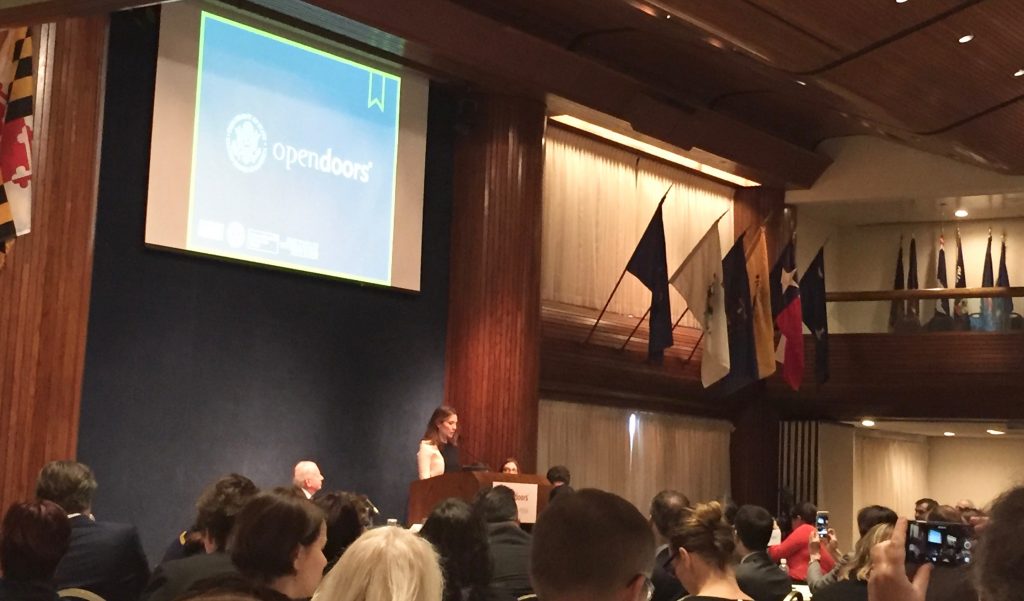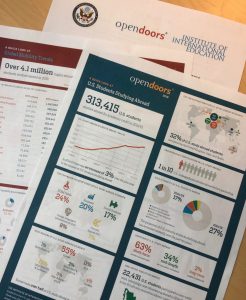To kick off International Education Week, the Institute of International Education (IIE) released the 2016 Open Doors Report on International Educational Exchange on Monday, November 14, 2016. The report offers helpful insight into the trends of incoming and outgoing study abroad students, which this year continued to demonstrate the ever-growing popularity and importance of studying abroad.

The headline finding this year is that in the 2015/16 academic year, U.S. Universities welcomed more than 1 million international students (up 7% from the year prior). This impressive milestone is being celebrated alongside important increases in U.S. students studying abroad around the world in the 2014/15 academic year.
Overall, 313,415 U.S. students studied abroad for academic credit in the 2014/15 academic year, reflecting a 3% increase over the prior year. This represents a total of 1.6% of all U.S. undergraduate students. Following are some key findings regarding this U.S. study abroad student population.
Destinations
Regionally, Europe remains the stronghold in U.S. study abroad destinations, hosting over half (54.5%) of total U.S. study abroad students in the 2014/15 academic year (a 5.3% increase over the year prior). As a destination, Europe outpaced the overall 3% study abroad growth.
Within Europe, a few particular countries saw important increases, namely Greece (18.3% increase) and Ireland (15.9% increase), whose government committed significant resources toward attracting study abroad students. Other notable increases include the Czech Republic (14.6% increase) and Denmark (13.8% increase). The United Kingdom, Italy, and Spain remained the top 3 U.S. study abroad destinations in the 2014/15 academic year, each receiving 12.2%, 10.8%, and 9% of total students, respectively. Despite being the top destination, the United Kingdom saw a small decrease in students (- 0.2%), which may be further impacted by Brexit. Italy continued its strong growth with an 8.3% increase over the prior academic year.
Sub-Saharan Africa saw a substantial decline in U.S. study abroad students, likely due to the Ebola outbreak in 2014. Countries experiencing the largest declines in the 2014/15 academic year include Argentina (13.8% decrease), Brazil (9.2% decrease), and China (7.1% decrease).
Fields of Study
The top five major fields of study of U.S. study abroad students in the 2014/15 academic year were:
- STEM fields: 24%
- Business & Management: 20%
- Social Sciences: 17%
- Foreign Languages & International Studies: 8%
- Fine & Applies Arts: 7%
Both the Science, Technology, Engineering and Math (STEM) and Business and Management fields grew at a faster rate than the overall study abroad growth, with STEM seeing a 9.1% increase and Business and Management a 5.6% increase. While at 20% STEM is the top field of study in U.S. study abroad, it remains underrepresented in study abroad as a percentage of total U.S. undergraduate majors. Social Sciences saw a 5% decrease from the year prior.

Program Types
Much of the U.S. student study abroad growth in the 2014/15 academic year came from short-term study abroad programs (63% of U.S. study abroad), defined as summer or 8 weeks or less. This continues the trend away from long-term programs (3% of U.S. study abroad), defined as academic or calendar year. Often a short-term program abroad can help to inspire students to pursue longer stays in the future, whether through study abroad or adult travel.
While the Open Doors findings focus on students who receive academic credit abroad, non-credit abroad experiences (work, intern, and volunteer) were also taken into account. Although this is a much more difficult number to count, 373 institutions reported 22,431 U.S. students completed such programs in 2014/15, with 37% traveling to Latin America and the Caribbean.
It should be noted that the report does not collect data on Gap Year programs.
Race/Ethnicity and Gender
While there was an increase in students who identify themselves as members of minority groups studying abroad in the 2014/15 academic year (27% total), the growth was modest, and the percentage is not representative of the diversity on U.S. college campuses.
The gender disparity in U.S. study abroad grew in the 2014/15 academic year, with women representing 66.6% of total students (up from 65.3% the year prior), and men representing 33.4% (down from 34.7% the year prior).
For more information on Open Doors 2016 data see www.iie.org/Open-Doors.


Comments
No comments yet